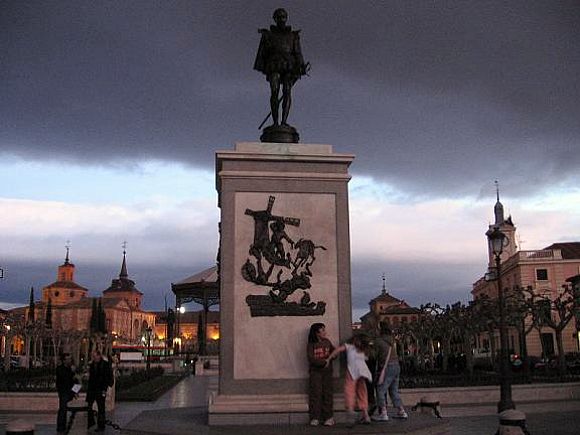Day Trip to Alcalá: Literary Roots
by Julie Espinosa

Alcalá de Henares, 25 km east of Madrid, is a charming UNESCO world heritage city worth a day trip. Its claim to fame is being the birthplace of Miguel de Cervantes, the author of Don Quijote de la Mancha.
1. Museo-Casa Cervantes: Learn here about Cervantes’ life and get a glimpse of life in the 17th century and copies of Don Quijote on display. Free admission.
2. Universidad de Alcalá: Tour the university campus, spread through the city center, which boasts very old buildings and a particularly impressive main façade. You can also see the city’s native stork population roosting overhead.
3. Plaza de Cervantes: Stroll the main plaza of the city, anchored by a statue of its namesake. Nearby is the city tourist office and an art exhibition space in the Capilla de Oidor. Alacalaínos love to congregate here, especially around sunset.
4. Calle Mayor: Explore this pedestrian-only cobblestone street to the north of Plaza de Cervantes, with its shops and cafés.
5. Semana Cervantina: If you can visit for Cervantes’ birthday celebration (October 9), you’ll be in for a week-long medieval festival and other events paying homage to the author.
You can get to Alcalá in about 40 minutes via Cercanías lines C-1, C-2 or C-7, departing from Atocha in Madrid.
See map below for locations mentioned above: Read more »


 How would you like to speak Spanish just like the local Madrileños next time you are in town?
How would you like to speak Spanish just like the local Madrileños next time you are in town? Spanish food is wonderful. Well, except for callos (tripe)! Which is what I think King Juan Carlos was actually complaining about. “¿Por qué no tienen callos?” is
Spanish food is wonderful. Well, except for callos (tripe)! Which is what I think King Juan Carlos was actually complaining about. “¿Por qué no tienen callos?” is  Since the demise of the much-loved Bluefish a couple of years ago, the word ‘brunch’ in Madrid has become synonymous with mounting gloom. Take
Since the demise of the much-loved Bluefish a couple of years ago, the word ‘brunch’ in Madrid has become synonymous with mounting gloom. Take 
 This week I was one of the first visitors to
This week I was one of the first visitors to 
 It’s common for Spanish workers to take a lunch break in the middle of their working day. The usual thing is to go out to a restaurant and have a menú del día, menu of the day. This set lunch consists of a starter, a second course, and a dessert, with several options for each, at a fair price — from 9 euros depending on the restaurant. The price also includes bread and a drink — water, soft drinks, wine or beer. You’ll find menus del día in a good portion of Spanish restaurants from Monday to Friday at lunch time — between about 1 pm and 3.30 pm. Check near the door of the restaurant or on a board outside for options for that particular day.
It’s common for Spanish workers to take a lunch break in the middle of their working day. The usual thing is to go out to a restaurant and have a menú del día, menu of the day. This set lunch consists of a starter, a second course, and a dessert, with several options for each, at a fair price — from 9 euros depending on the restaurant. The price also includes bread and a drink — water, soft drinks, wine or beer. You’ll find menus del día in a good portion of Spanish restaurants from Monday to Friday at lunch time — between about 1 pm and 3.30 pm. Check near the door of the restaurant or on a board outside for options for that particular day. I hate Sushi. My wife knows this, so she had to lie to get me here. Well, maybe not lie, but certainly not reveal our exact location until it was way too late to change the arrangements with friends.
I hate Sushi. My wife knows this, so she had to lie to get me here. Well, maybe not lie, but certainly not reveal our exact location until it was way too late to change the arrangements with friends.


